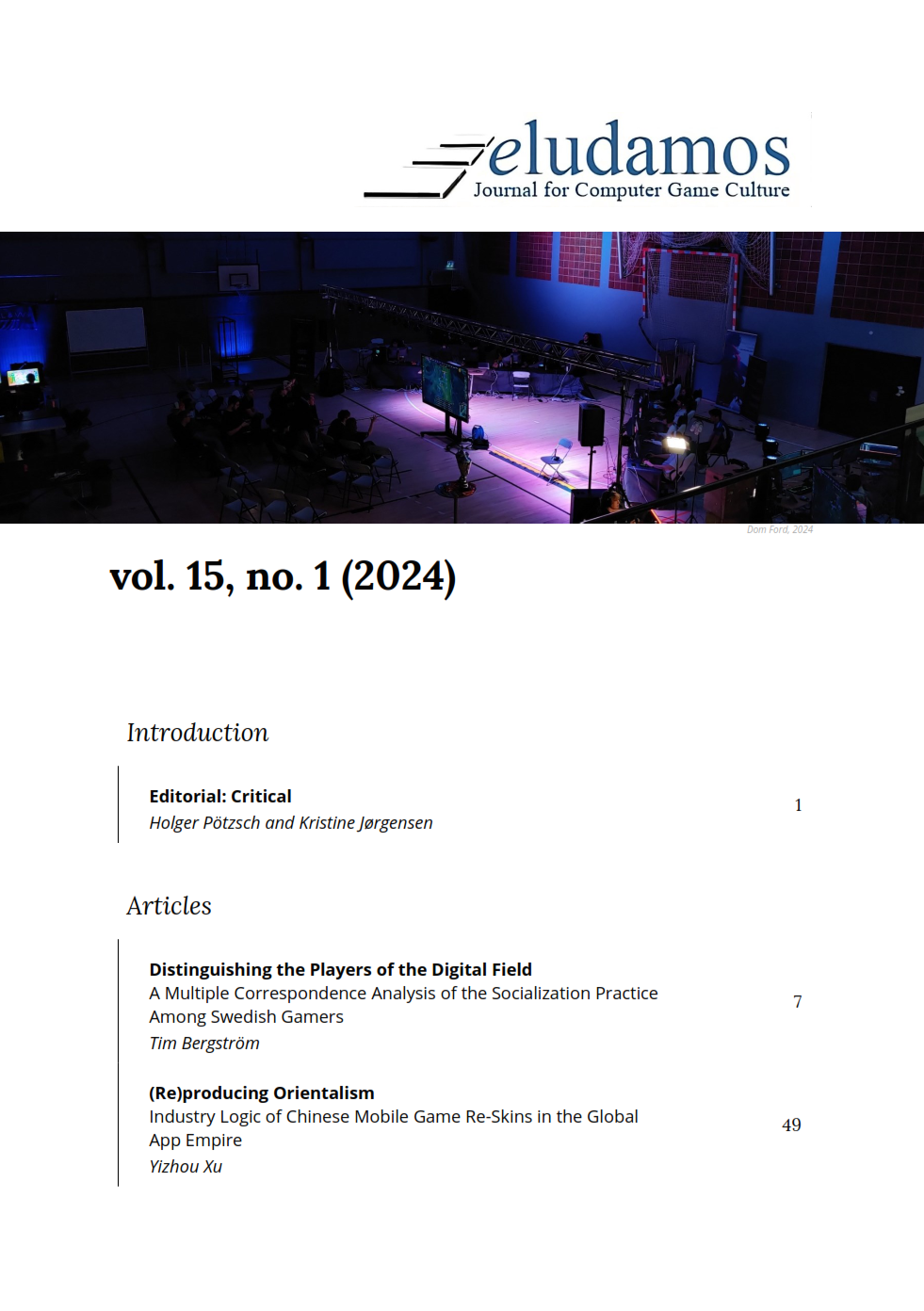Transgender emergence in video games
Intersections, discourses, directions
DOI:
https://doi.org/10.7557/23.7933Keywords:
transgender, independent video games, character customisation, gender dysphoria, player-avatar relationship, embodiment, queernessAbstract
Over the past two decades, trans theory has conceptualised gender identity and bodily autonomy, advocating for self-exploration and political affirmation (Nagoshi & Brzuzy, 2010; Stryker, 2017; Stryker & Whittle, 2006). This focus has resonated with game studies, which have examined video games as a medium for trans representation (Ruberg, 2020; Ruberg, 2022; Thach, 2021). This commentary explores the emergence of transgender identities in video games, outlining the state of the art of transgender representations and the experiences of trans players and designers. It highlights the significance of procedural elements such as character customisation, embodiment, and player-avatar relationship for transgender players. In doing so, it also suggests potential tensions and contradictions inherent in transgender emergence, arguing that while video games can provide positive and beneficial spaces for exploring gender identity, they may simultaneously perpetuate transphobia and exploit transgender experiences.
References
American Psychological Association. Answers to your questions about transgender people, gender identity, and gender expression. American Psychological Association. http://www.apa.org/topics/lgbt/transgender.aspx
Anthropy, A. (2012). Dys4ia [PC]. Newgrounds.
Baldwin, K. (2018). Virtual avatars: Trans experiences of ideal selves through gaming. Markets, Globalization & Development Review, 3(3). https://doi.org/ 10.23860/MGDR-2018-03-03-04 https://doi.org/10.23860/MGDR-2018-03-03-04
Banks, J., & Bowman, N. D. (2016). Avatars are (sometimes) people too: Linguistic indicators of parasocial and social ties in player–avatar relationships. New Media & Society, 18(7), 1257–1276. https://doi.org/10.1177/1461444814554898 https://doi.org/10.1177/1461444814554898
Billard, T. J. (2016). Writing in the margins: Mainstream news media representations of transgenderism. International Journal of Communication, 4193–4218. https://ijoc.org/index.php/ijoc/article/view/3461
BioWare. (2014). Dragon age: Inquisition [PC]. Electronic Arts.
Butler, J. P. (2024). Who‘s afraid of gender? Farrar, Straus and Giroux.
Cavalcante, A. (2017). Breaking into transgender life: Transgender audiences' experiences with “first of its kind” visibility in popular media. Communication, Culture & Critique, 10(3), 538–555. https://doi.org/10.1111/cccr.12165 https://doi.org/10.1111/cccr.12165
CD Projekt RED. (2020). Cyberpunk 2077 [PC]. CD Projekt.
Chang, E. Y. (2017). Queergaming. In B. Ruberg & A. Shaw (Eds.), Queer game studies (pp. 15–24). University of Minnesota Press. https://www.jstor.org/stable/ 10.5749/j.ctt1mtz7kr.5
Gass, A. (2024). Glitch as a trans representational mode in video games. NMC Media-N, 20(1), 5–27. https://doi.org/10.21900/j.median.v20i1.1207 https://doi.org/10.21900/j.median.v20i1.1207
Griffiths, M. D., Arcelus, J., & Bouman, W. P. (2016). Video gaming and gender dysphoria: Some case study evidence, Aloma: revista de psicologia, ciències de l’educació i de l’esport Blanquerna, 34(2), 59–66. https://www.raco.cat/index.php/Aloma/article/view/315262 https://doi.org/10.51698/aloma.2016.34.2.59-66
Klevjer, R. (2022). What is the avatar? Fiction and embodiment in avatar-based singleplayer computer games. transcript Verlag. https://doi.org/10.1515/9783839445792
Kosciesza, A. J. (2022). The moral service of trans NPCs: Examining the roles of transgender non-player characters in role-playing video games. Games and Culture, 18(2), 189–208. https://doi.org/10.1177/15554120221088118 https://doi.org/10.1177/15554120221088118
Lacey, L. (2023). “A checkbox on a character sheet”: Nonbinary gender representations in video games. The iJournal: Student Journal of the Faculty of Information, 8(2). https://doi.org/10.33137/ijournal.v8i2.41032 https://doi.org/10.33137/ijournal.v8i2.41032
Larian Studios. (2023). Baldur’s Gate 3 [PC]. Larian Studios.
Liang, S., Cormier, M. V., Toups Dugas, P. O., & Bohrer, R. (2023). Analyzing trans (mis)representation in video games to remediate gender dysphoria triggers. Proceedings of the ACM on Human-Computer Interaction, 7(CHI PLAY), 369–401. https://doi.org/10.1145/3611034 https://doi.org/10.1145/3611034
Maddy Makes Games. (2018). Celeste [PC]. Maddy Makes Games.
Maxis. (2014). The Sims 4 [PC]. Electronic Arts.
McCue, T. (2022). He fucked the girl out of me. Taylor McCue.
McKenna, J. L., Wang, Y., Williams, C. R., McGregor, K., & Boskey, E. R. (2024). “You can’t be deadnamed in a video game”: Transgender and gender diverse adolescents' use of video game avatar creation for gender-affirmation and exploration. Journal of LGBT Youth, 21(1), 29–49. https://doi.org/10.1080/ 19361653.2022.2144583 https://doi.org/10.1080/19361653.2022.2144583
McPhail, K. (2023). Reflecting on Celeste: Abstracting trans representation. Games and Culture. https://doi.org/10.1177/15554120231204148 https://doi.org/10.1177/15554120231204148
Morgan, H., O’Donovan, A., Almeida, R., Lin, A., & Perry, Y. (2020). The role of the avatar in gaming for trans and gender diverse young people. International Journal of Environmental Research and Public Health, 17(22), 8617. https://doi.org/10.3390/ijerph17228617 https://doi.org/10.3390/ijerph17228617
Naughty Dog. (2020). The last of us part II [PC]. Sony Interactive Entertainment.
Nagoshi, J. L., & Brzuzy, S. I. (2010). Transgender theory: Embodying research and practice. Affilia, 25(4), 431–443. https://doi.org/10.1177/0886109910384068 https://doi.org/10.1177/0886109910384068
npckc. (2018). One night, hot springs [PC]. npckc.
Ruberg, B. (2019a). Video games have always been queer. NYU Press. https://doi.org/10.18574/nyu/9781479893904.001.0001
Ruberg, B. (2019b). The precarious labor of queer indie game-making: Who benefits from making video games “better”? Television & New Media, 20(8), 778–788. https://doi.org/10.1177/1527476419851090 https://doi.org/10.1177/1527476419851090
Ruberg, B. (2020). The queer games avant-garde. Duke University Press. https://doi.org/10.1515/9781478007302
Ruberg, B. (2022). Trans game studies. JCMS: Journal of Cinema and Media Studies, 61(2), 200–205. https://doi.org/10.1353/cj.2022.0006 https://doi.org/10.1353/cj.2022.0006
Ruberg, B., & Shaw, A. (Eds.). (2017). Queer game studies. University of Minnesota Press.
Shaw, A. (2009). Putting the gay in games. Games and Culture, 4(3), 228–253. https://doi.org/10.1177/1555412009339729 https://doi.org/10.1177/1555412009339729
Shaw, A., & Friesem, E. (2016). Where is the queerness in games? Types of lesbian, gay, bisexual, transgender, and queer content in digital games. International Journal of Communication, 3877. https://ijoc.org/index.php/ijoc/article/view/5449
Stryker, S. (2017). Transgender history: The roots of today’s revolution (2nd ed.). Seal Press.
Stryker, S., & Whittle, S. (2006). The transgender studies reader. Routledge.
Thach, H. (2021). A cross-game look at transgender representation in video games. Press Start, 7(1). https://press-start.gla.ac.uk/index.php/press-start/article/view/187
Ubisoft Montreal. (2016). Watch dogs 2 [PC]. Ubisoft.
Waggoner, Z. (2009). My avatar, my self: Identity in video role-playing games. McFarland.
Whitehouse, K., Hitchens, M., & Matthews, N. (2023). Trans and gender diverse players: Avatars and gender-alignment. Entertainment Computing, 47. https://doi.org/10.1016/j.entcom.2023.100584 https://doi.org/10.1016/j.entcom.2023.100584
Downloads
Published
How to Cite
Issue
Section
License
Copyright (c) 2024 Robin Longobardi Zingarelli

This work is licensed under a Creative Commons Attribution 4.0 International License.







